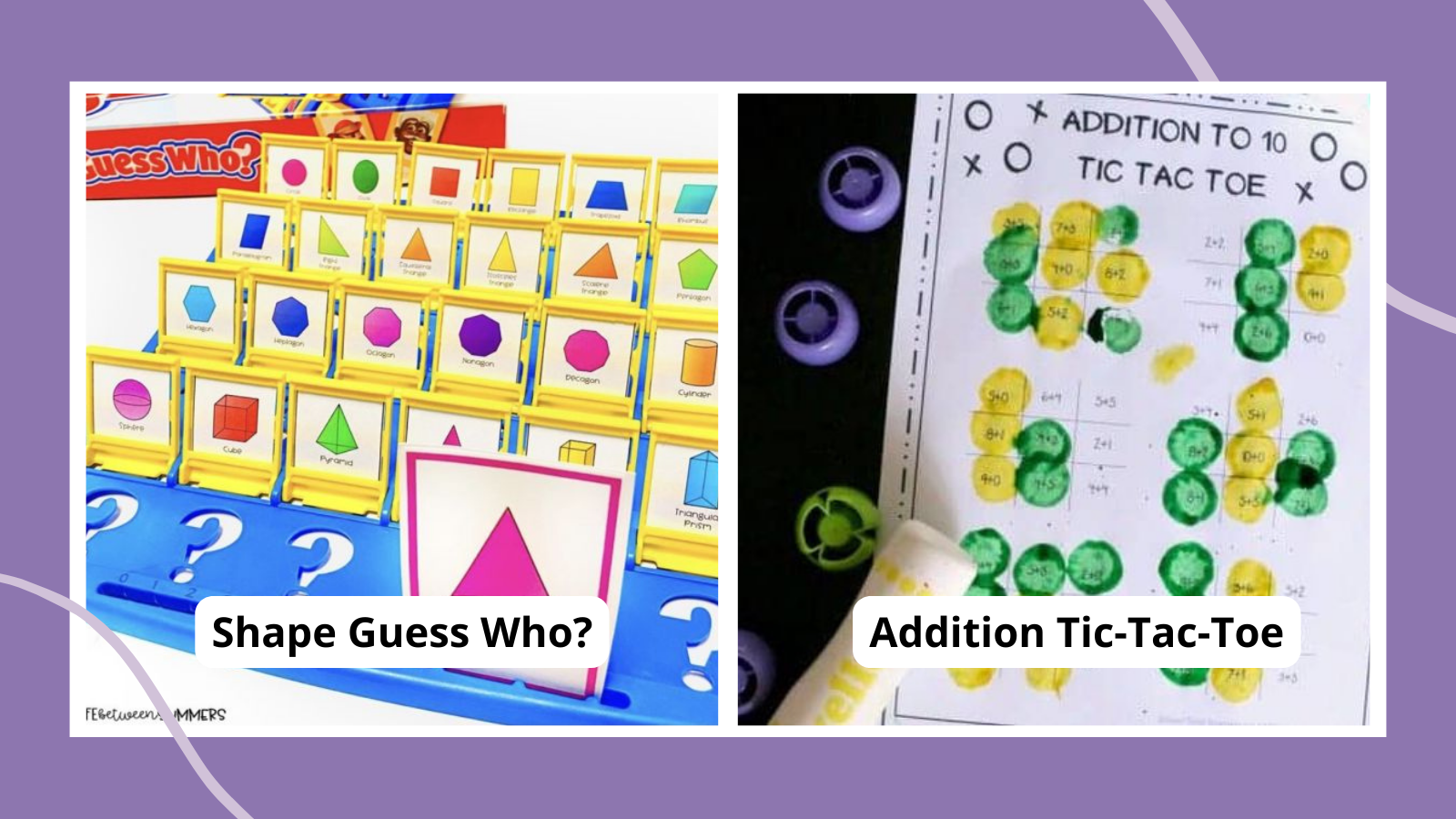Early elementary teachers have a chance to instill in their students a love of math right from the start. One great way to do that is to make math fun! These first grade math games cover all the standard skills firsties need to know, in ways that make learning engaging and enjoyable for all.
(Just a heads up, WeAreTeachers may collect a share of sales from the links on this page. We only recommend items our team loves!)
1. Wiggle to 100
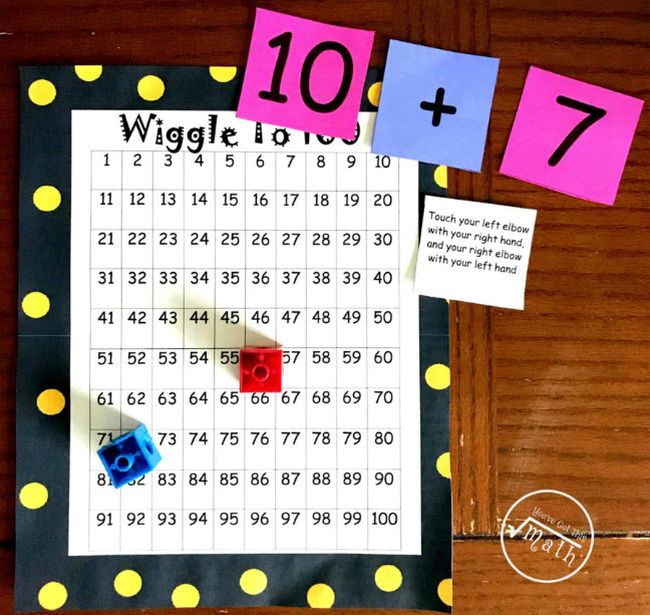
You’ve Got This Math/Wiggle to 100 via youvegotthismath.com
Many kids learn best when they move their bodies. In this simple game, they use number cards to make and solve addition or subtraction equations. Then they draw an action card, and complete the activity the same number of times as the answer to the problem.
Learn more: You’ve Got This Math
2. Play with place value pickup sticks

First Grade Wow/Place Value Pickup Sticks via firstgradewow.blogspot.com
Help students visualize place value with these DIY pickup sticks. Pick up a handful of sticks and drop them, then have kids organize them by tens and ones. Finally, determine what number the sticks represent.
Learn more: First Grade Wow
3. Measure and compare names
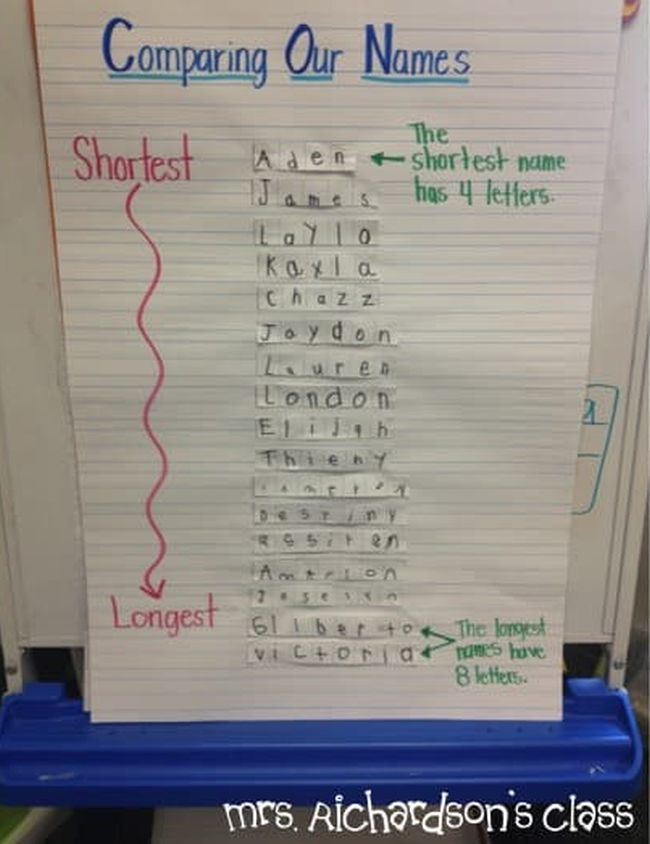
Mrs. Richardson’s Class/Comparing Names via mrsrichardsonsclass.com
Here’s a fun way to teach non-standard measurement: Compare the lengths of student names! This is a great activity to try near the beginning of the year as kids get to know each other.
Learn more: Mrs. Richardson’s Class
4. Spin and draw the time

The Moffatt Girls/Spin and Draw Time via themoffattgirls.com
Kids love simple spinners, so use them for games that help them learn to tell time. After they spin a digital time, have them draw the correct hands on clock faces or create the time on a toy clock.
Learn more: The Moffatt Girls
5. Make a DIY shape Guess Who? game

Life Between Summers/Shape Guess Who via lifebetweensummers.com
Switch up your old Guess Who? game with 2D and 3D shape cards instead. Kids will get practice using geometry terms like “vertices,” “edges,” “faces,” and more.
Learn more: Life Between Summers
6. Walk the plank to practice addition
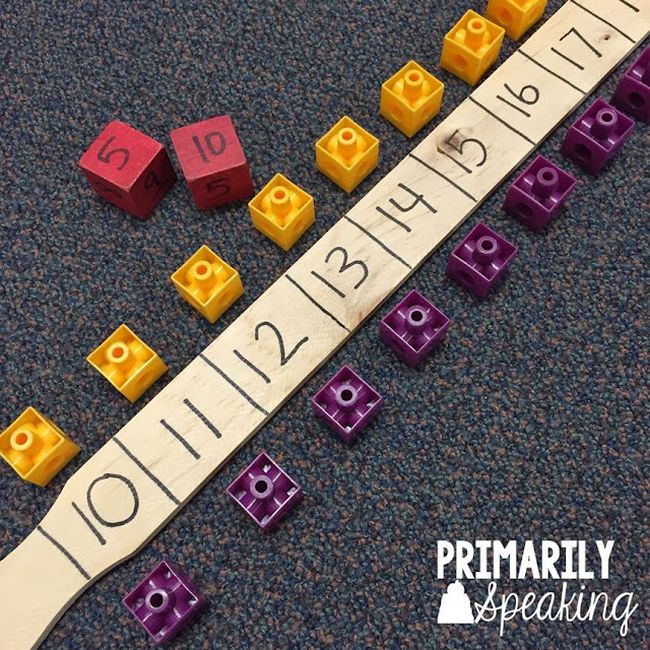
Primarily Speaking/Walk the Plank via primarily-speaking.com
With a wooden paint stick, some math cubes, and a pair of number cubes, you can play a simple but fun first grade math game that helps kids learn addition in such an engaging way!
Learn more: Primarily Speaking
7. Assemble a domino puzzle

Games 4 Gains/Dominoes Math Puzzles via games4gains.com
Print the free puzzles at the link below. Then grab some dominoes and start filling in the puzzle one piece at a time by placing a domino that adds up to the number shown in each rectangle. The trick is that regular domino rules still apply, so each number must touch another domino with the same number on that end.
Learn more: Games 4 Gains
8. Play tic-tac-toe with addition problems
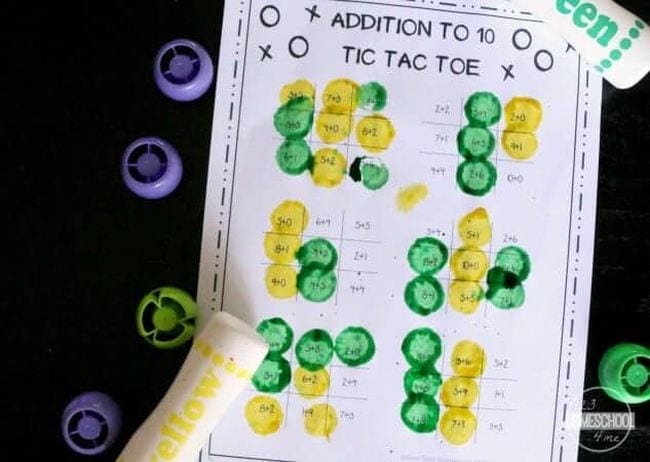
123 Homeschool 4 Me/Tic-Tac-Toe Math Game via 123homeschool4me.com
Work out the answer to each problem in the grid, and dot or circle the ones that add up to 10. First to get three in a row wins!
Learn more: 123 Homeschool 4 Me/Tic-Tac-Toe Math Game
9. Face off in Dice War
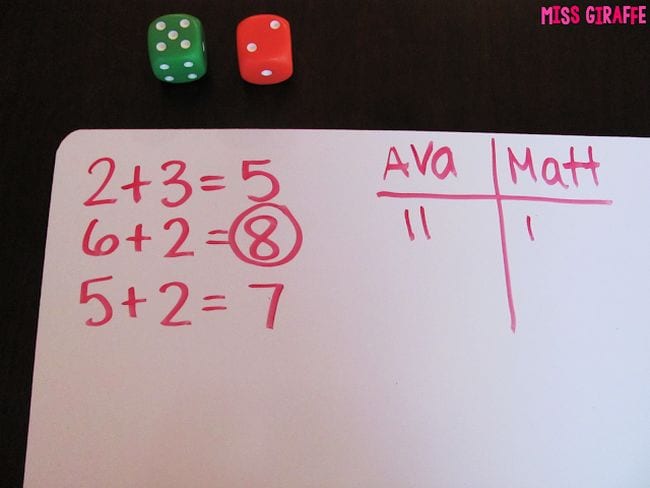
Miss Giraffe’s Class/Fact Fluency Dice via missgiraffesclass.blogspot.com
Dice games are fantastic in the classroom! With this one, kids practice their addition facts and get a little work with subitizing too. The concept is so simple: Each player rolls the dice and adds up their numbers. The highest sum wins that round. This is one of those first grade math games that can be expanded by adding a third die. (You can also use playing cards.)
Learn more: Miss Giraffe’s Class
10. Use sticky notes to make 10

Life Over C’s/Make 10 Sticky Notes via lifeovercs.com
Sticky notes have so many uses in the classroom. In this case, challenge students to put together the numbered notes that “make 10.” They’ll practice adding to 10 with multiple numbers. You can also do this with subtraction, starting at 10, to make zero.
Learn more: Life Over C’s
11. Play Shut the Box
This game has been played for hundreds of years, but it’s a fun and sneaky way to practice addition facts fluency. The goal is to “close” each of the numbers in the box from one to nine by rolling the dice. For instance, if a player rolls 11, they may close 1, 2, 3, and 5, as these add up to 11. If no numbers are available to add up to the dice total, play passes to the next player and continues until someone finally “shuts the box” by closing the last available number. You can play this game with a specially designed box, as it has been played for years. You don’t need the box, though; simply have kids write out the numbers 1 through 9 and cross them out as they play.
12. Assemble some addition grab bags
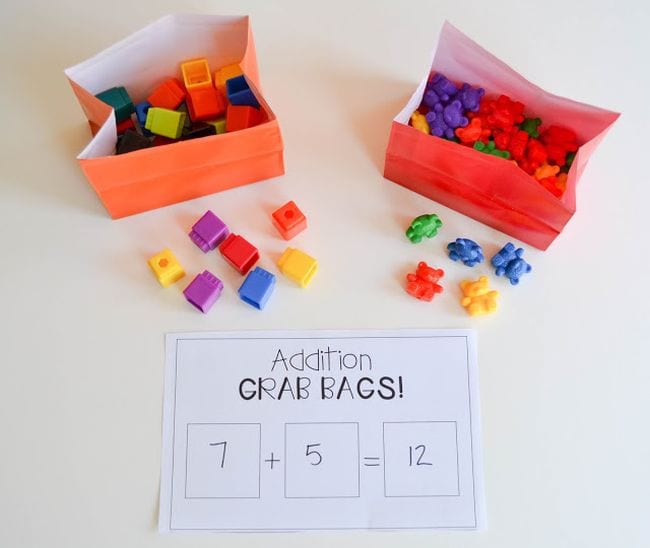
Susan Jones Teaching/Addition Grab Bags via susanjonesteaching.com
Fill a variety of bags with collections of small objects. Kids grab a handful from two different bags, then count and add up the results. Be sure they write it all down to get practice at setting up equations. First grade math games like this one work for subtraction too.
Learn more: Susan Jones Teaching/Grab Bags
13. Face off to find the difference
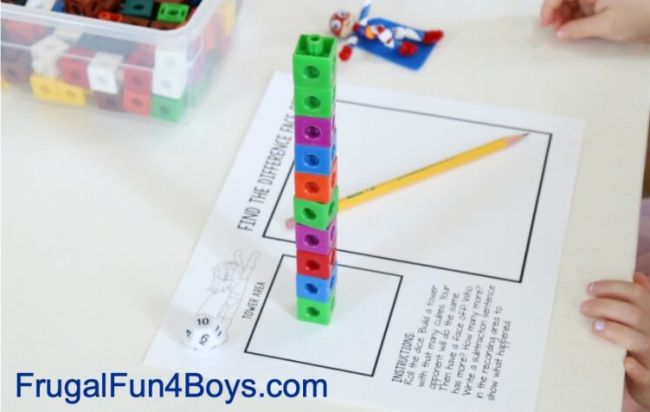
Frugal Fun for Boys and Girls/Face Off Math via frugalfun4boys.com
Each player rolls the dice (try polyhedral dice for higher numbers, or roll several dice and add them together) and builds a stack of math cubes. Then they “face off” and find the difference between their two stacks.
Learn more: Frugal Fun for Boys and Girls
14. Plant flowers and count on
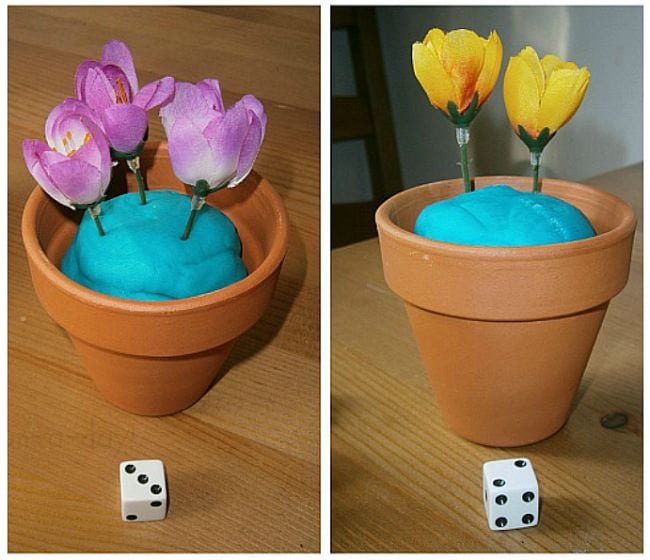
Fun-a-Day/Counting Flowers via fun-a-day.com
Pick up some artificial flowers at the dollar store for this springtime garden game. Roll the die and add that number of flowers to your pot. Then roll again and add more, counting on from where you left off. Easy and fun!
Learn more: Fun-a-Day
15. Build and count on
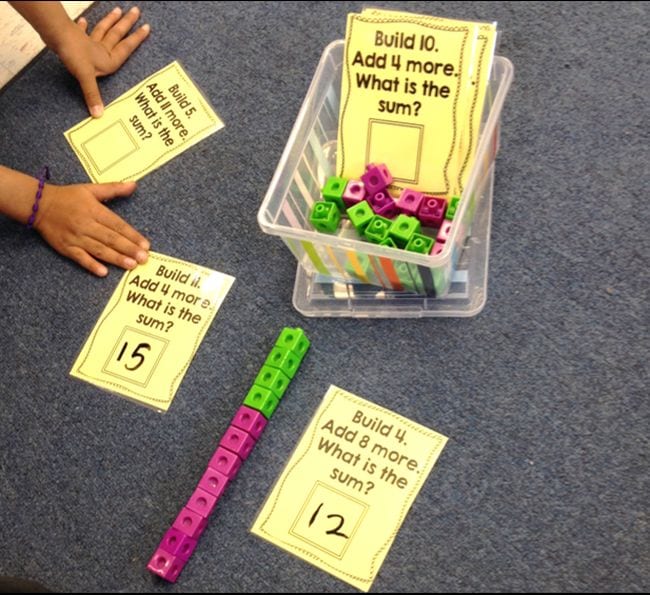
Susan Jones Teaching/Building On via susanjonesteaching.com
Here’s a fun hands-on way to practice counting on and addition. You can use any type of building blocks for this one. Get free printables at the link.
Learn more: Susan Jones Teaching/Building On
16. Print a hundreds chart to play Battleship
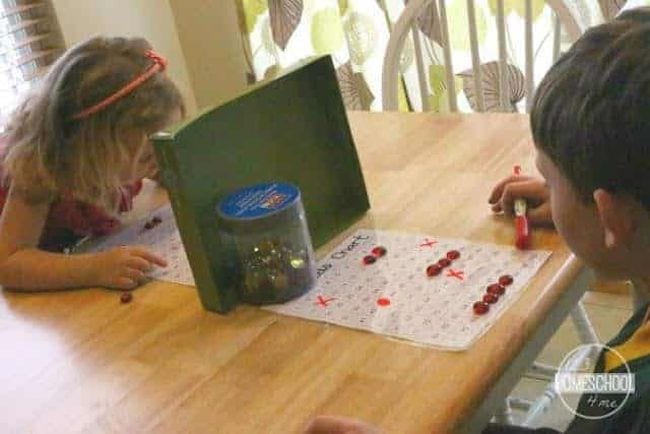
123 Homeschool 4 Me/Hundreds Chart Battleship via 123homeschool4me.com
Help students master numbers up to 100 by playing Battleship, using a standard hundreds chart. They’ll enjoy the strategy (and the fun of crying “boom!” when they sink a ship) while they develop number sense and practice number words.
Learn more: 123 Homeschool 4 Me/Hundreds Chart Battleship
17. Try nuts and bolts for place-value practice
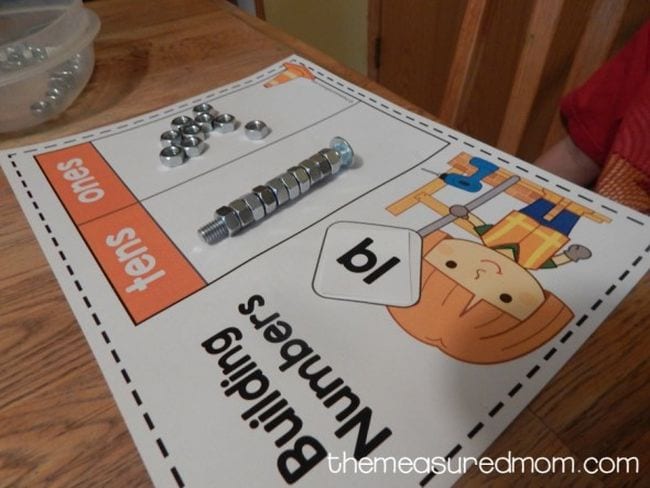
The Measured Mom/Place Value Mat via themeasuredmom.com
Mastering the concepts of tens and ones is more fun with hands-on activities. We love these DIY math manipulatives that use inexpensive nuts and bolts from the hardware store to drive home the idea of place value. (Bonus: Kids also practice fine motor skills!) Get free printable mats to use with this activity at the link.
Learn more: The Measured Mom
18. Have a place-value scavenger hunt
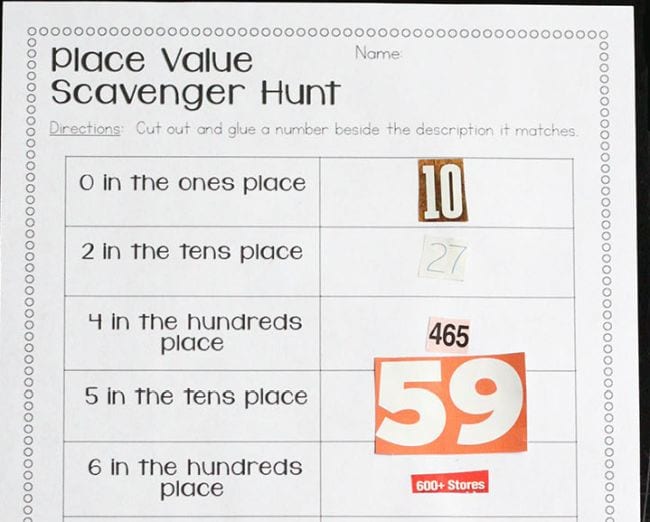
Primary Theme Park/Place Value Scavenger Hunt via primarythemepark.com
Grab a stack of old magazines and use it for a place-value scavenger hunt! You can do this one at school or send it home for homework. Get free printables to use for this first grade math game at the link.
Learn more: Primary Theme Park/Place Value Scavenger Hunt
19. Practice tens and ones with I Have, Who Has

Playdough to Plato/I Have Who Has via playdoughtoplato.com
As first graders work with the concepts of tens and ones, play this simple game to give them confidence. Using the free printable cards at the link, the first player calls out “I have …” followed by the number shown on their card in blocks. Then they call out the number on the bottom, and the player who has that number takes over.
Learn more: Playdough to Plato/I Have, Who Has
20. Deal Uno cards to compare numbers
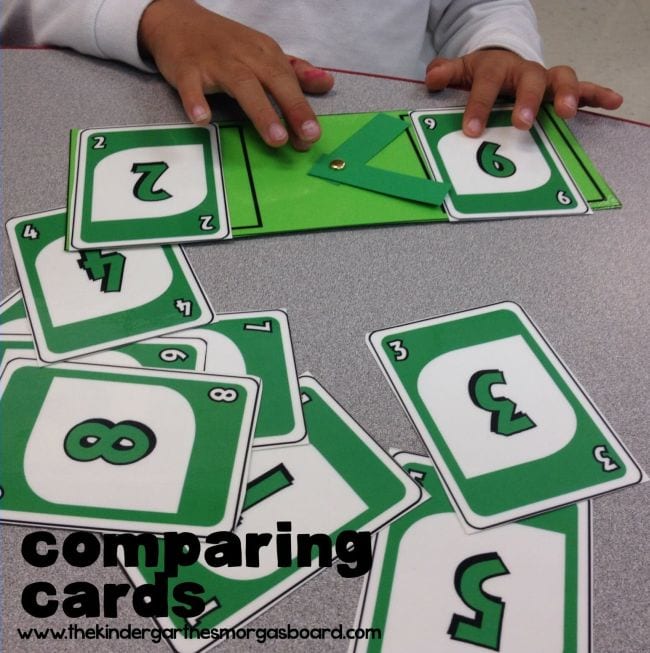
Kindergarten Smorgasboard/Uno Card Comparison via thekindergartensmorgasboard.com
Some first grade math games are just slightly harder versions of kindergarten ones. Make a greater-than/less-than mat with paper scraps and a brad, as shown. Lay out two Uno cards on each side, since first graders work on comparing two-digit numbers. Swing the arms of the signs around to the correct direction to indicate which is greater.
Learn more: The Kindergarten Smorgasboard
21. Knock down the pins with dot arrangement bowling
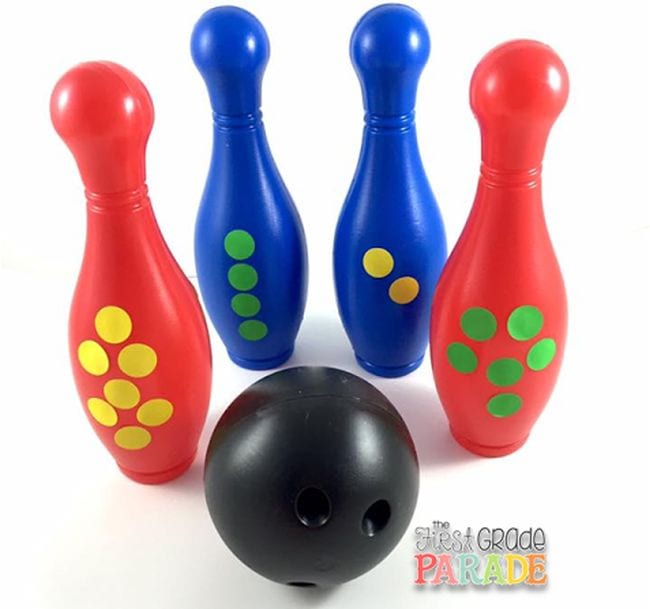
Cara Carroll/Subitizing Bowling via justcaracarroll.com
Take an inexpensive toy bowling set (or make your own with plastic bottles) and add sticky dots arranged in patterns. Students roll the ball and then have to quickly subitize to determine how many dots are on each pin they knocked down. If they get it right, they get the points!
Learn more: Cara Carroll
22. Navigate a time-telling maze
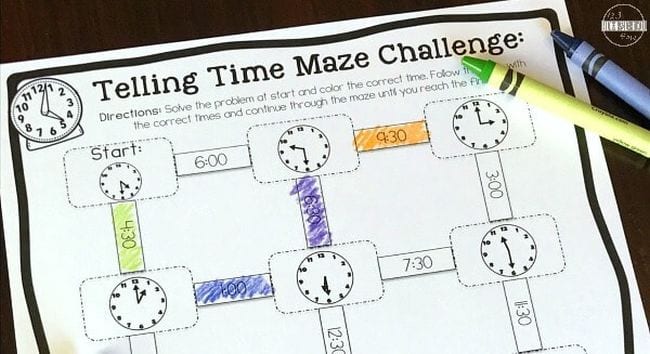
123 Homeschool 4 Me/Time Maze via 123homeschool4me.com
Start with the first clock and color in the line that shows the correct time. That leads you to the next clock, and so on, until you’re done!
Learn more: 123 Homeschool 4 Me/Time-Telling Maze
23. Assemble time-telling puzzles

123 Homeschool 4 Me/Time-Telling Puzzles via 123homeschool4me.com
Firsties should be mastering time to the hour and half hour. These free printable puzzles help them match up analog and digital clock times. Have them say the times out loud as they match them up too.
Learn more: 123 Homeschool 4 Me/Time-Telling Puzzles
24. Match up plastic eggs

The STEM Laboratory/Telling Time Eggs via thestemlaboratory.com
This is always a popular way to practice telling time. Draw clocks on one half of the eggs, and write out the times in numbers or words on the other half. For even more fun, hide the halves around the room and go on an egg hunt before you match them up!
Learn more: The STEM Laboratory
25. Put together shapes to make other shapes
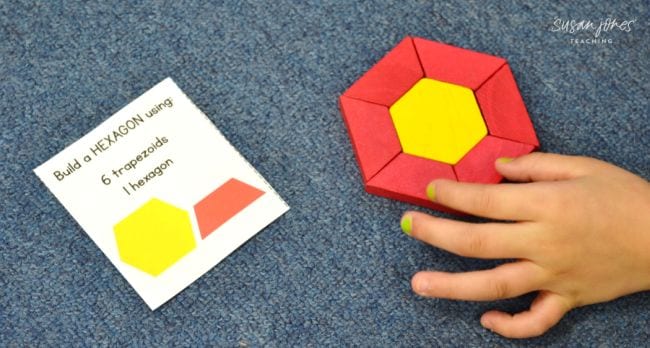
Susan Jones Teaching/Pattern Blocks via Susan Jones Teaching
Use pattern blocks with the free printable cards at the link to get kids playing around with simple geometry. They’ll practice recognizing basic shapes and learn they can use some shapes to make new ones.
Learn more: Susan Jones Teaching/Pattern Blocks
26. Partition and sort shapes

Smitten With First/Fraction Sticky Notes via smittenwithfirstblog.com
Gather up sticky notes in a variety of shapes and sizes. Draw lines on them to partition them equally or unequally. Then, have kids sort them based on type.
Learn more: Smitten With First
27. Build and measure with LEGO bricks
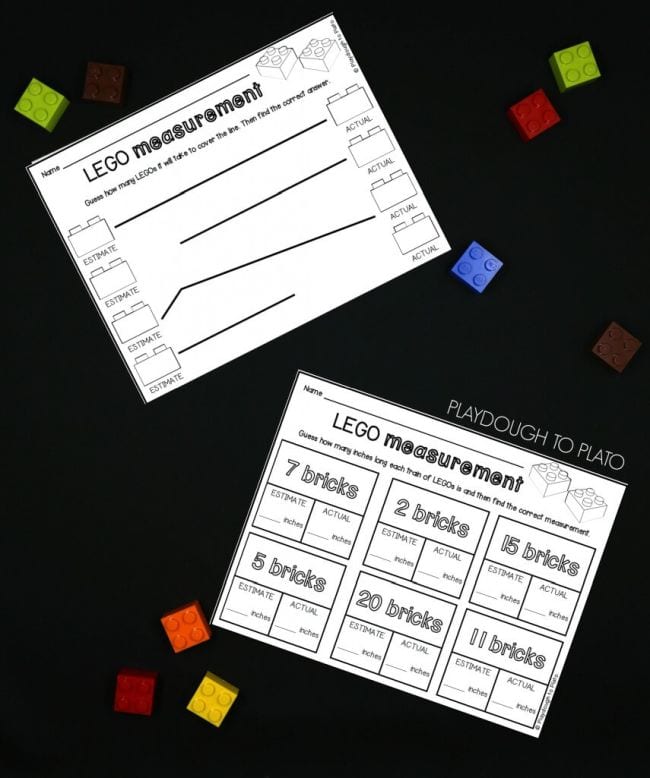
Playdough to Plato/LEGO Math via playdoughtoplato.com
Everything is more fun with LEGO! Pull out a pile of square bricks and use them for these fun and free activities that incorporate estimating, measuring, and comparing length.
Learn more: Playdough to Plato/LEGO Math
28. Race and measure with toy cars
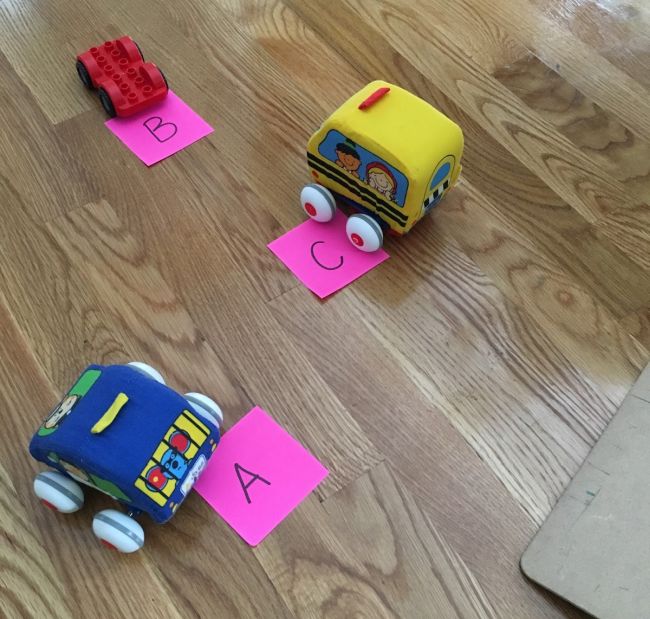
Susan Jones Teaching/Non-Standard Measurement via susanjonesteaching.com
First, kids get a little STEM practice by figuring out how to build a ramp. Then, they race toy cars down the ramp, marking where they land. Finally, they compare distances using any kind of non-standard measurement they like.
Learn more: Susan Jones Teaching/Non-Standard Measurement
29. Sort out your classroom toys
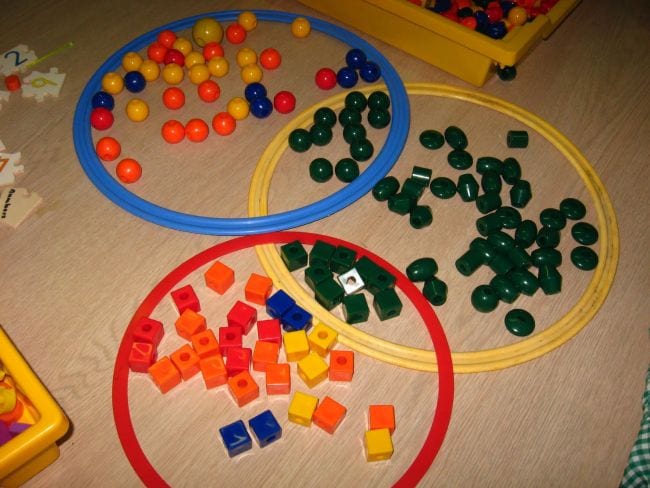
BSM Year 2/Sorting Toys via bsmkew.blogspot.com
First graders work on sorting by attribute in as many as three categories. Put out a variety of building blocks, beads, or other classroom toys and lay out some Hula-Hoops. Ask kids to define the categories and start sorting! You can even overlap the hoops into Venn diagrams for items that meet more than one criterion.
Learn more: BSM Year 2
30. Go on a bug hunt
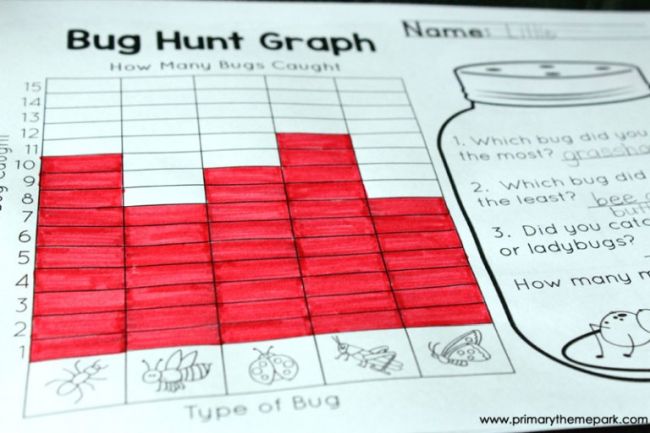
Primary Theme Park/Bug Hunt via primarythemepark.com
Grab the free printable game at the link, then have kids graph their insects as they play. When they’re done, ask questions to ensure they understand the data they’ve collected.
Learn more: Primary Theme Park/Bug Hunt
Like these first grade math games? Don’t miss these 50 First Grade Math Word Problems of the Day!
Teachers deserve a strong support system. Find yours on the WeAreTeachers HELPLINE group on Facebook.
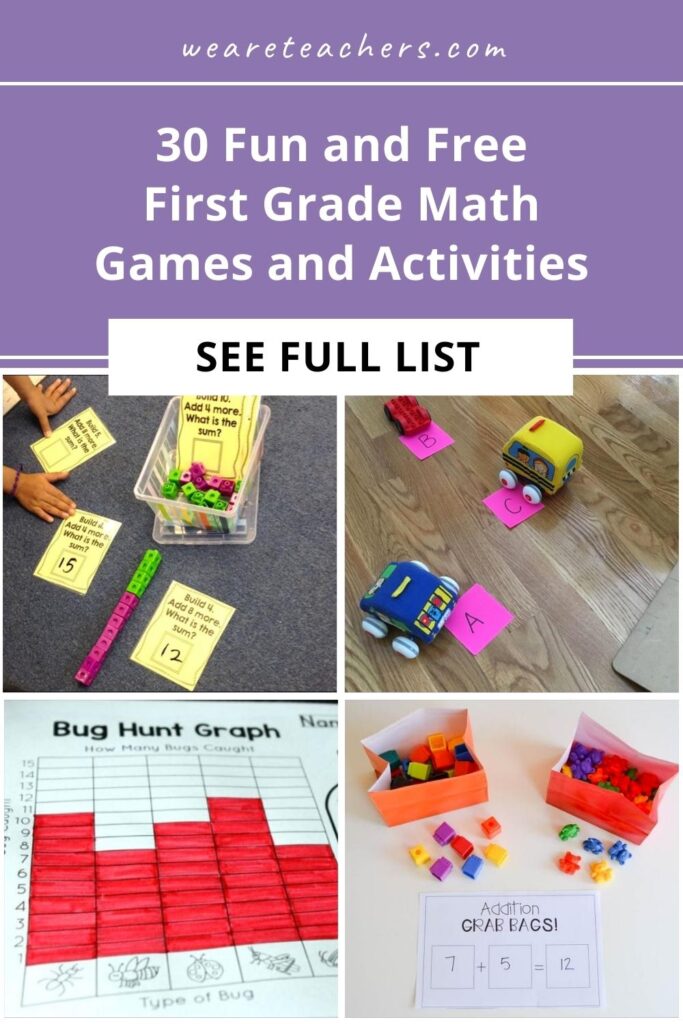
We Are Teachers
